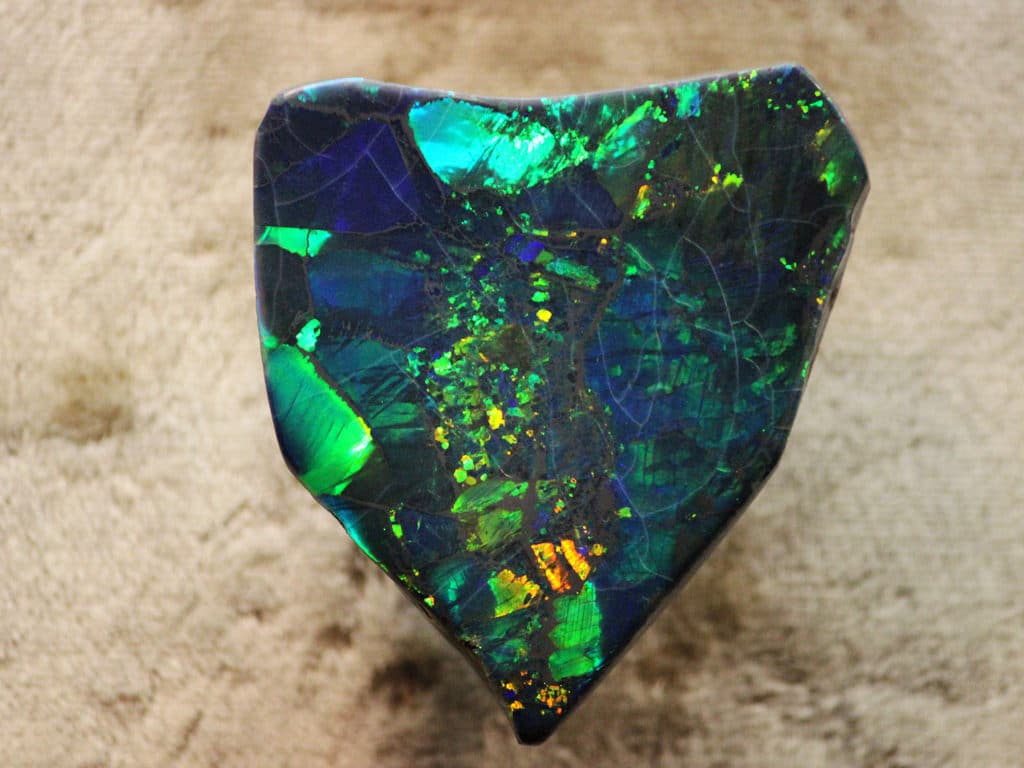Blog
The official birthstone for October, opals are one of the world’s most magnificent stones with their flashing bolts of vivid colour. In fact, opals have long been a part of jewellery history, with some of these stones achieving celebrity status. And so, without further ado, here is our pick of the world’s most famous opals.
Halley’s Comet Opal
Weight: 1,982.5 carats
Dimensions: 10 x 6.6 x 6.3cm
Found: 1986
Estimated worth: $1.2 million
Current location: Unknown
The Halley’s Comet Opal was unearthed in 1986, when Halley’s Comet could be seen from earth, and where it got its name. A group of opal miners found the stone at Lightning Ridge on the Leaning Tree Claim, also known as “The Lunatic Hill Syndicate”. This stunning opal holds a number of records: according to the Guinness Book of World Records, it is the largest uncut black opal nodule in the world; it is the third largest gem-grade black opal ever recorded; and the largest one in existence!
The Fire of Australia
Weight: 4,990 carats
Dimensions:
Found: 1946
Estimated worth: $500,000
Current location: South Australian Museum
Also known as “The Monster”, the Fire of Australia was mined in 1946 by Walter Bartram at the Eight Mile field in Coober Pedy in South Australia. Bartram was the son of a farmer, Jack Bartram, who had been forced off his land during the depression. Jack, however, saw the potential of the newly-discovered Eight Mile Plains and encouraged his children and their families to try their luck at mining the region. The stone stayed in the Bartram family until 2017, when it was sold for $500,000 to the South Australian Museum thanks to AU$455,000 in funding from the government’s National Cultural Heritage Account and a private donor.
The Black Prince Opal
Weight: 181 carats
Dimensions: 7.62cm x 4.7cm
Found: 1915
Estimated worth: Unknown
Current location: Unknown
Originally named the Harlequin Prince, The Black Prince was uncovered in 1915 at Phone Line by Tom Urwin and Snowy Brown. After its discovery, this magnificent opal was bought by a wealthy American in England, who later donated it to the New York Museum of Natural History, before the stone moved to the Forest Lawn Memorial Cemetery in Los Angeles. Unfortunately in 1991, the stone was stolen, along with another opal called The Pride of Australia.
The Pride of Australia
Weight: 225 carats
Dimensions: 5.08cm x 7.62cm
Found: 1915
Estimated worth: Unknown
Current location: Unknown
Also called the Red Emperor, the Pride of Australia is another opal that was discovered in 1915 at Phone by Urwin and Brown. The stone featured blue veins and firey red streaks across a black background and, by 1954, had toured five World Fairs under the title of “The Greatest Opal of Australia”. In 1920, Ernie Sherman bought the stone (along with three others) for £2000, while it was later sold from the Percy Marks Collection to the Forest Lawn Memorial Cemetery in Los Angeles in the 1950s. Unfortunately, the Pride of Australia was stolen along with The Black Prince and its location remains a mystery to this day.
The Flame Queen Opal
Weight: 263.18 carats
Dimensions: 7cm x 6.3cm x 1.2cm
Found: 1914
Estimated worth: Unknown
Current location: Privately owned
This famous red on black opal is one of the most easily recognisable jewels in the world, with its unique “fried egg” appearance. The centre of the opal sports brilliantly vivid sparks of red, orange, yellow and bronze, while the outer ring features splashes of green, blue and turquoise. The stone was discovered in 1914 at Bald Hill Workings, Lightning Ride by three men: Walter Bradley, Jack Philips, and Joe Hegarty, who sold the stone for a paltry £93. This well-travelled opal has been featured in numerous exhibitions and events such as the Geological Museum in London (for the Coronation of King George VI in 1937), the Gemological Institute in London (as part of the Kelsey I. Newman Collection in 1980), and the Jack Plane Collection. This opal has exchanged hands many times but was finally bought in 2008 by a private collector.
Do you want to become part of history with your own beautiful opal jewellery? Get in touch with the friendly jewellers at Volle today and learn more about our free opal tour!

